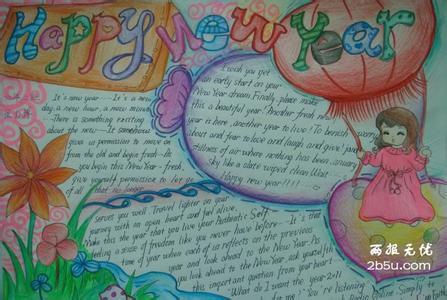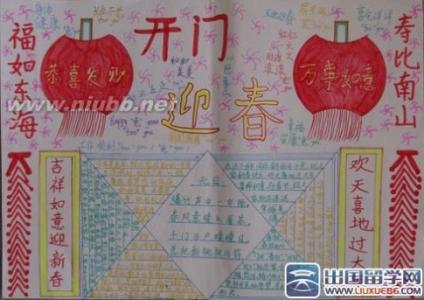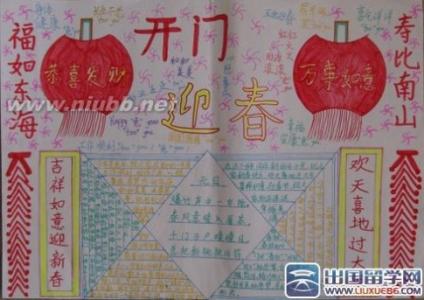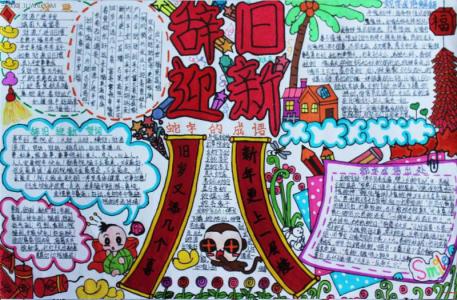2014马年春节英语手抄报内容资料大全
一、春节的英文介绍中文部分
春节,是农历正月初一,又叫阴历年,俗称“过年”。这是我国民间最隆重、最热闹的一个传统节日。春节的历史很悠久,它起源于殷商时期年头岁尾的祭神祭祖活动。按照我国农历,正月初一古称元日、元辰、元正、元朔、元旦等,俗称年初一,到了民国时期,改用公历,公历的一月一日称为元旦,把农历的一月一日叫春节。
春节到了,意味着春天将要来临,万象复苏草木更新,新一轮播种和收获季节又要开始。人们刚刚度过冰天雪地草木凋零的漫漫寒冬,早就盼望着春暖花开的日子,当新春到来之际,自然要充满喜悦载歌载舞地迎接这个节日。千百年来,人们使年俗庆祝活动变得异常丰富多彩,每年从农历腊月二十三日起到年三十,民间把这段时间叫做“迎春日”,也叫“扫尘日”,在春节前扫尘搞卫生,是我国人民素有的传统习惯。
三联阅读配图
然后就是家家户户准备年货,节前十天左右,人们就开始忙于采购物品,年货包括鸡鸭鱼肉、茶酒油酱、南北炒货、糖饵果品,都要采买充足,还要准备一些过年时走亲访友时赠送的礼品,小孩子要添置新衣新帽,准备过年时穿。
在节前要在住宅的大门上粘贴红纸黄字的新年寄语,也就是用红纸写成的春联。屋里张贴色彩鲜艳寓意吉祥的年画,心灵手巧的姑娘们剪出美丽的窗花贴在窗户上,门前挂大红灯笼或贴福字及财神、门神像等,福字还可以倒贴,路人一念福倒了,也就是福气到了,所有这些活动都是要为节日增添足够的喜庆气氛。
春节的另一名称叫过年。在过去的传说中,年是一种为人们带来坏运气的想象中的动物。年一来。树木凋蔽,百草不生;年一过,万物生长,鲜花遍地。年如何才能过去呢?需用鞭炮轰,于是有了燃鞭炮的习俗,这其实也是烘托热闹场面的又一种方式。
春节是个欢乐祥和的节日,也是亲人团聚的日子,离家在外的孩子在过春节时都要回家欢聚。过年的前一夜,就是旧年的腊月三十夜,也叫除夕,又叫团圆夜,在这新旧交替的时候,守岁是最重要的年俗活动之一,除夕晚上,全家老小都一起熬年守岁,欢聚酣饮,共享天伦之乐,北方地区在除夕有吃饺子的习俗,饺子的作法是先和面,和字就是合;饺子的饺和交谐音,合和交有相聚之意,又取更岁交子之意。在南方有过年吃年糕的习惯,甜甜的粘粘的年糕,象征新一年生活甜蜜蜜,步步高。待第一声鸡啼响起,或是新年的钟声敲过,街上鞭炮齐鸣,响声此起彼伏,家家喜气洋洋,新的一年开始了,男女老少都穿着节日盛装,先给家族中的长者拜年祝寿,节中还有给儿童压岁钱,吃团年饭,初二、三就开始走亲戚看朋友,相互拜年,道贺祝福,说些恭贺新喜、恭喜发财、恭喜、过年好等话,祭祖等活动。
节日的热烈气氛不仅洋溢在各家各户,也充满各地的大街小巷,一些地方的街市上还有舞狮子,耍龙灯,演社火,游花市,逛庙会等习俗。这期间花灯满城,游人满街,热闹非凡,盛况空前,直要闹到正月十五元宵节过后,春节才算真正结束了。
春节是汉族最重要的节日,但是满、蒙古,瑶、壮、白、高山、赫哲、哈尼、达斡尔、侗、黎等十几个少数民族也有过春节的习俗,只是过节的形式更有自己的民族特色,更蕴味无穷。
春节的英文介绍英文部分
Spring Festival
The Spring Festival is the most important festival for the Chinese people and is when all family members get together, just like Christmas in the West. All people living away from home go back, becoming the busiest time for transportation systems of about half a month from the Spring Festival. Airports, railway stations and long-distance bus stations are crowded with home returnees.
The Spring Festival falls on the 1st day of the 1st lunar month, often one month later than the Gregorian calendar. It originated in the Shang Dynasty (c. 1600 BC-c. 1100 BC) from the people's sacrifice to gods and ancestors at the end of an old year and the beginning of a new one.
Strictly speaking, the Spring Festival starts every year in the early days of the 12th lunar month and will last till the mid 1st lunar month of the next year. Of them, the most important days are Spring Festival Eve and the first three days. The Chinese government now stipulates people have seven days off for the Chinese Lunar New Year.
Many customs accompany the Spring Festival. Some are still followed today, but others have weakened.
On the 8th day of the 12th lunar month, many families make laba porridge, a delicious kind of porridge made with glutinous rice, millet, seeds of Job's tears, jujube berries, lotus seeds, beans, longan and gingko.
The 23rd day of the 12th lunar month is called Preliminary Eve. At this time, people offer sacrifice to the kitchen god. Now however, most families make delicious food to enjoy themselves.
After the Preliminary Eve, people begin preparing for the coming New Year. This is called "Seeing the New Year in".
Store owners are busy then as everybody goes out to purchase necessities for the New Year. Materials not only include edible oil, rice, flour, chicken, duck, fish and meat, but also fruit, candies and kinds of nuts. What's more, various decorations, new clothes and shoes for the children as well as gifts for the elderly, friends and relatives, are all on the list of purchasing.
Before the New Year comes, the people completely clean the indoors and outdoors of their homes as well as their clothes, bedclothes and all their utensils.

Then people begin decorating their clean rooms featuring an atmosphere of rejoicing and festivity. All the door panels will be pasted with Spring Festival couplets, highlighting Chinese calligraphy with black characters on red paper. The content varies from house owners' wishes for a bright future to good luck for the New Year. Also, pictures of the god of doors and wealth will be posted on front doors to ward off evil spirits and welcome peace and abundance.
The Chinese character "fu" (meaning blessing or happiness) is a must. The character put on paper can be pasted normally or upside down, for in Chinese the "reversed fu" is homophonic with "fu comes", both being pronounced as "fudaole." What's more, two big red lanterns can be raised on both sides of the front door. Red paper-cuttings can be seen on window glass and brightly colored New Year paintings with auspicious meanings may be put on the wall.
People attach great importance to Spring Festival Eve. At that time, all family members eat dinner together. The meal is more luxurious than usual. Dishes such as chicken, fish and bean curd cannot be excluded, for in Chinese, their pronunciations, respectively "ji", "yu" and "doufu," mean auspiciousness, abundance and richness. After the dinner, the whole family will sit together, chatting and watching TV. In recent years, the Spring Festival party broadcast on China Central Television Station (CCTV) is essential entertainment for the Chinese both at home and abroad. According to custom, each family will stay up to see the New Year in.
Waking up on New Year, everybody dresses up. First they extend greetings to their parents. Then each child will get money as a New Year gift, wrapped up in red paper. People in northern China will eat jiaozi, or dumplings, for breakfast, as they think "jiaozi" in sound means "bidding farewell to the old and ushering in the new". Also, the shape of the dumpling is like gold ingot from ancient China. So people eat them and wish for money and treasure.
Southern Chinese eat niangao (New Year cake made of glutinous rice flour) on this occasion, because as a homophone, niangao means "higher and higher, one year after another." The first five days after the Spring Festival are a good time for relatives, friends, and classmates as well as colleagues to exchange greetings, gifts and chat leisurely.
Burning fireworks was once the most typical custom on the Spring Festival. People thought the spluttering sound could help drive away evil spirits. However, such an activity was completely or partially forbidden in big cities once the government took security, noise and pollution factors into consideration. As a replacement, some buy tapes with firecracker sounds to listen to, some break little balloons to get the sound too, while others buy firecracker handicrafts to hang in the living room.
The lively atmosphere not only fills every household, but permeates to streets and lanes. A series of activities such as lion dancing, dragon lantern dancing, lantern festivals and temple fairs will be held for days. The Spring Festival then comes to an end when the Lantern Festival is finished.
China has 56 ethnic groups. Minorities celebrate their Spring Festival almost the same day as the Han people, and they have different customs.
二、the Origin of Chinese New Year
中国春节的由来
the Chinese New Year is now popularly known as the Spring Festival because it starts from the Begining of Spring (the first of the twenty-four terms in coodination with the changes of Nature). Its origin is too old to be traced. Several explanations are hanging around. All aGREe, however, that the word Nian, which in modern Chinese solely means "year", was originally the name of a monster beast that started to prey on people the night before the beginning of a new year.
One legend goes that the beast Nian had a very big mouth that would swallow a GREat many people with one bite. People were very scared. One day, an old man came to their rescue, offering to subdue Nian. To Nian he said, "I hear say that you are very capable, but can you swallow the other beasts of prey on earth instead of people who are by no means of your worthy opponents?" So, it did swallow many of the beasts of prey on earth that also harrassed people and their domestic animals from time to time.
After that, the old man disappeared riding the beast Nian. He turned out to be an immortal god. Now that Nian is gone and other beasts of prey are also scared into forests, people begin to enjoy their peaceful life. Before the old man left, he had told people to put up red paper decorations on their windows and doors at each year's end to scare away Nian in case it sneaked back again, because red is the color the beast feared the most.
From then on, the tradition of observing the conquest of Nian is carried on from generation to generation. The term "Guo Nian", which may mean "Survive the Nian" becomes today "Celebrate the (New) Year" as the word "guo" in Chinese having both the meaning of "pass-over" and "observe". The custom of putting up red paper and firing fire-crackers to scare away Nian should it have a chance to run loose is still around. However, people today have long forgotten why they are doing all this, except that they feel the color and the sound add to the excitement of the celebration.
 爱华网
爱华网


